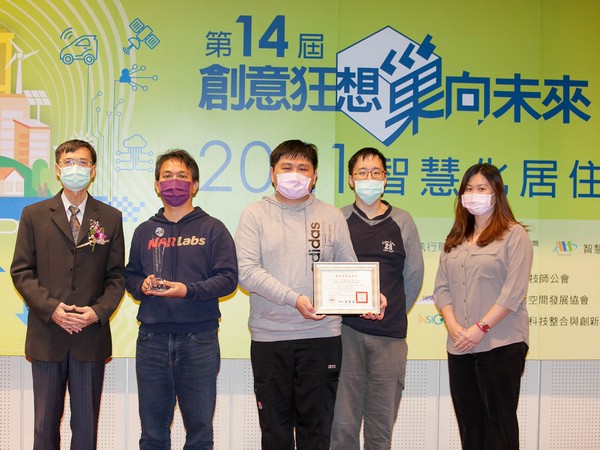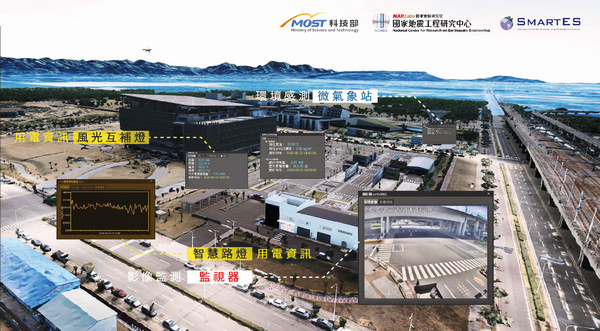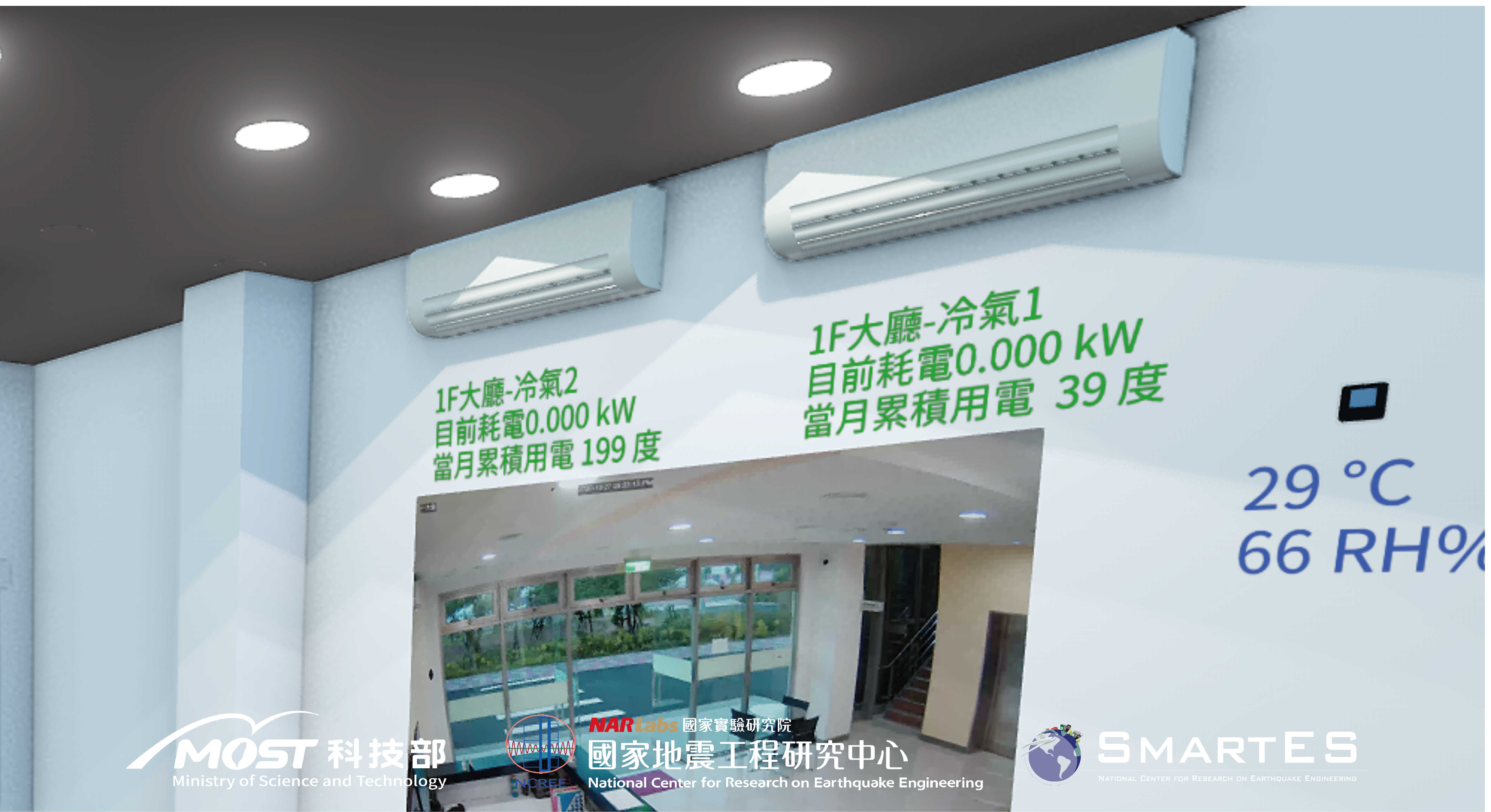The Shalun 5D Smart Management System of the National Center for Research on Earthquake Engineering Awarded the Highest Honor
2022-01-14
The Ministry of Science and Technology is committed to promoting a smart life that combines energy saving behavior, environmental protection, and safety. To live a smart life, the National Center for Research on Earthquake Engineering (NCREE) of the National Applied Research Laboratories developed a 5D Smart City Platform, which has been adopted into the Tainan Shalun Smart Green Energy Science City (SSGES-City) Zone-C, an application field for smart green energy technology research and development. By integrating various types of data into the platform, such as indoor environment sensors and electricity consumption data, administrators can quickly access equipment information through the visualization management system and take immediate countermeasures when abnormal conditions occur. For its empirical applications, this Shalun 5D Smart Management System was awarded the highest honor of a gold award at the 14th Smart Living Space Creative Competition hosted by the Architecture and Building Research Institute of the Ministry of the Interior.
Integrating multiple management systems to fully grasp changes in the field
Dr. Ren-Zuo Wang, the head of the 5D Smart City Platform development team at the NCREE, said that smart cities are embodied in the integrated and value-added applications of large data sets and are widely used in various fields. With the development of the Internet of Things technology, the importance of integrated information such as fire protection, energy management, environmental monitoring, building monitoring, and outdoor smart streetlights is evident.
However, at this stage, each system is an independent management platform, resulting in decentralized management. Therefore, the 5D Smart City Platform was developed; this 5D visualization management platform that integrates virtual and real spaces was applied in the SSGES-City Zone-C as the Shalun 5D Smart Management System. The system integrates sensors at the Cyber Security and Smart Technology R&D Building and the Taiwan CAR Laboratory. Sensors include those for air-conditioning, lighting, surveillance videos, car chargers, solar panels, and micro weather stations. Building administrators can access equipment information through the visualization management system and view real-time data to fully grasp various environmental changes in the field.
Energy-saving, safe, and quick response time: reducing time consumption and costs
Through the Shalun 5D Smart Management System visualization platform, the temperature, humidity, carbon monoxide concentration, carbon dioxide concentration, and lighting brightness of each monitoring point are visible. This system can also remotely control the temperature of air conditioners and electrical appliances such as fans, lighting, projectors, and electric curtains to achieve energy-saving effects.
The Shalun 5D Smart Management System can also display the cumulative power consumption of a building, the cumulative power consumption of each floor, and the cumulative power consumption of each room and its proportion, which can be used to estimate the electricity costs of the leased space and help with managing the electricity consumption of the building.
The video surveillance system of the Shalun 5D Smart Management System is also completely different from traditional systems. Traditionally, the screen is divided into many small screens to allow for watching multiple different monitors simultaneously. In this system, a 3D real scene model of the field is built. Through the system calculations, the user can combine multiple monitor screens and 3D models. It is possible to watch the surveillance screen at any angle of rotation and intuitively establish the correlation between the image and the actual environment.
Through this visual management system, the location of various devices is also clear at a glance. The Shalun 5D Smart Management System will help to improve the efficiency of data searches, save a lot of query time, and can improve processing efficiency and quick responses in the event of an emergency. It can also reduce on-site management manpower and costs.
Integrating multiple management systems to fully grasp changes in the field
Dr. Ren-Zuo Wang, the head of the 5D Smart City Platform development team at the NCREE, said that smart cities are embodied in the integrated and value-added applications of large data sets and are widely used in various fields. With the development of the Internet of Things technology, the importance of integrated information such as fire protection, energy management, environmental monitoring, building monitoring, and outdoor smart streetlights is evident.
However, at this stage, each system is an independent management platform, resulting in decentralized management. Therefore, the 5D Smart City Platform was developed; this 5D visualization management platform that integrates virtual and real spaces was applied in the SSGES-City Zone-C as the Shalun 5D Smart Management System. The system integrates sensors at the Cyber Security and Smart Technology R&D Building and the Taiwan CAR Laboratory. Sensors include those for air-conditioning, lighting, surveillance videos, car chargers, solar panels, and micro weather stations. Building administrators can access equipment information through the visualization management system and view real-time data to fully grasp various environmental changes in the field.
Energy-saving, safe, and quick response time: reducing time consumption and costs
Through the Shalun 5D Smart Management System visualization platform, the temperature, humidity, carbon monoxide concentration, carbon dioxide concentration, and lighting brightness of each monitoring point are visible. This system can also remotely control the temperature of air conditioners and electrical appliances such as fans, lighting, projectors, and electric curtains to achieve energy-saving effects.
The Shalun 5D Smart Management System can also display the cumulative power consumption of a building, the cumulative power consumption of each floor, and the cumulative power consumption of each room and its proportion, which can be used to estimate the electricity costs of the leased space and help with managing the electricity consumption of the building.
The video surveillance system of the Shalun 5D Smart Management System is also completely different from traditional systems. Traditionally, the screen is divided into many small screens to allow for watching multiple different monitors simultaneously. In this system, a 3D real scene model of the field is built. Through the system calculations, the user can combine multiple monitor screens and 3D models. It is possible to watch the surveillance screen at any angle of rotation and intuitively establish the correlation between the image and the actual environment.
Through this visual management system, the location of various devices is also clear at a glance. The Shalun 5D Smart Management System will help to improve the efficiency of data searches, save a lot of query time, and can improve processing efficiency and quick responses in the event of an emergency. It can also reduce on-site management manpower and costs.






